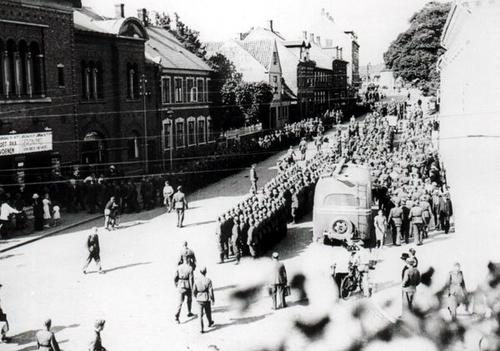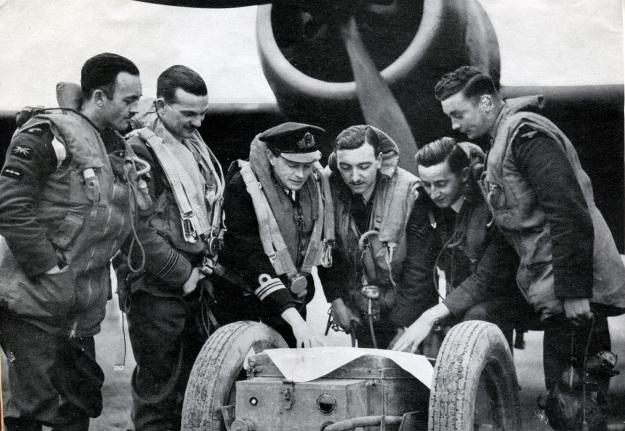Saturday 20 April 1940
 |
| Wehrmacht troops in Copenhagen, marching to celebrate Hitler's birthday, 20 April 1940. |
London does not tell General de Wiart of the cancellation of Operation Hammer. He disposes of his forces to support the expected landing, which now will not come. His 146th Brigade occupies advanced positions on Trondheimfjord which are only useful and supportable if the expected landings were to occur.
German forces approach Lillehammer and Rena. At 02:50, Brigadier Morgan moves his 148th Brigade south to Lillehammer by train. The Norwegians are trying to block the Germans advancing up either side of Lake Mjøsa and are giving ground.
The German 196th Infantry Division captures Elverum, the former refuge of the Norwegian government, and pushes north toward Trondheim.
The German forces at Narvik under General Dietl are reinforced by a battalion of 334th Infantry Regiment brought in by Junkers Ju 52 transport planes. Otherwise, they are completely cut off from all re-supply and reinforcement, with the exception of any cargo ships that can make it past the British blockade.
Norway Air Operations: The Luftwaffe launches attacks on Namsos, heavily damaging the harbor installations and largely ruining the port for the British. They sink British trawler HMS Rutlandshire. The Luftwaffe is beginning to demonstrate aerial dominance over Norway. This dominance is aided by the lack of adequate British anti-aircraft guns and air cover. Piles of supplies and equipment are destroyed on the single stone wharf, which also is obliterated.
The Luftwaffe attacks British naval units and transports off Norway without success, losing three of their number.
The Luftwaffe is starting to support the advancing Wehrmacht ground forces heading north toward Trondheim. Among other places, they attack Dombås, the scene of the recent German paratrooper landings and fighting. Aside from the important rail line, it also is a key road junction at the intersection of long mountain defiles. There are British soldiers there, brought down by the rail line that runs through the town. One of the British, Lt. Rob Winter, notes: "Luftwaffe been strafing us all day, and bombing the little town of Dombas. We left our flak guns in the UK."
During the night, the RAF bombs airfields at Kristiansand and Stavanger in Norway, and Aalborg in Denmark, all without loss. The RAF also sends 23 aircraft to lay mines off the German coast during the night.
European Air Operations: RAF 263 Squadron flies 18 Gloster Gladiators (Squadron Leader John Donaldson) to Scapa Flow, where, they are landed on aircraft carrier HMS Glorious for transport to Norway. The Gladiators are not designed for landings and takeoffs on aircraft carriers, nor are their pilots, so Fleet Air Arm pilots carefully fly them onto the carrier.
The RAF shoots down two Bf 109s and two Heinkel He 111s over the western front.
The Luftwaffe night fighters get their first victory when they shoot down a Fairey Battle of the RAF Advanced Striking Force while it is on a reconnaissance mission.
Battle of the Atlantic: British freighters Mersey and Hawnby sink after hitting mines.
Two US freighters in Norwegian ports, Flying Fish and Charles McCormick, have been moved from Bergen to more secure locations to prevent any "incidents."
Convoy OA 133GF departs from Southend, Convoy OB 33 departs from Liverpool.
U-120 (Oberleutnant zur See Ernst Bauer) is commissioned.
Denmark: The government demobilizes the military.
RAF: The Royal Air Force begins training of aircrew from the commonwealth nations pursuant to the Empire Air Training Scheme. This is later known as the British Commonwealth Air Training Plan.
Air Marshal Keith Park takes over command of Fighter Command No. 11 Group.
German Military: Partially in celebration of his birthday and partly to honor the success of the current campaign in Scandinavia, Hitler orders the creation of a special Waffen SS regiment to be composed of Danish and Norwegian volunteers. It will be called the "Viking" Division.
US Navy: Captain George J. McMillin becomes the new Commandant of the US Naval Station at Guam.
Science: The first public demonstration of an electron microscope is held in Philadelphia, Pennsylvania by RCA.
German/Romanian Relations: The two countries conclude a trade agreement.
German Homefront: It is Hitler's 51st birthday, and the big day, as usual, is marked with celebrations and speeches.
 |
| Wehrmacht troops lined up to celebrate Hitler's birthday in Viborg, Denmark, April 20, 1940. |
April 1940
April 1, 1940: Weserubung is a GoApril 2, 1940: British Subs On Alert
April 3, 1940: Churchill Consolidates Power
April 4, 1940: Missed the Bus
April 5, 1940: Mig-1 First Flight
April 6, 1940: Troops Sailing to Norway
April 7, 1940: Fleets At Sea
April 8, 1940: HMS Glowworm and Admiral Hipper
April 9, 1940: Invasion of Norway
April 10, 1940: First Battle of Narvik
April 11, 1940: Britain Takes the Faroes
April 12, 1940: Germans Consolidate in Norway
April 13, 1940: 2d Battle of Narvik
April 14, 1940: Battle of Dombås
April 15, 1940: British in Norway
April 16, 1940: Germans Cut Norway in Half
April 17, 1940: Trondheim the Target
April 18, 1940: Norway Declares War
April 19, 1940: Dombås Battle Ends
April 20, 1940: Germans Advancing in Norway
April 21, 1940: First US Military Casualty
April 22, 1940: First British Military Contact with Germans
April 23, 1940: British Retreating in Norway
April 24, 1940: British Bombard Narvik
April 25, 1940: Norwegian Air Battles
April 26, 1940: Norwegian Gold
April 27, 1940: Allies to Evacuate Norway
April 28, 1940: Prepared Piano
April 29, 1940: British at Bodo
April 30, 1940: Clacton-on-Sea Heinkel
2019






